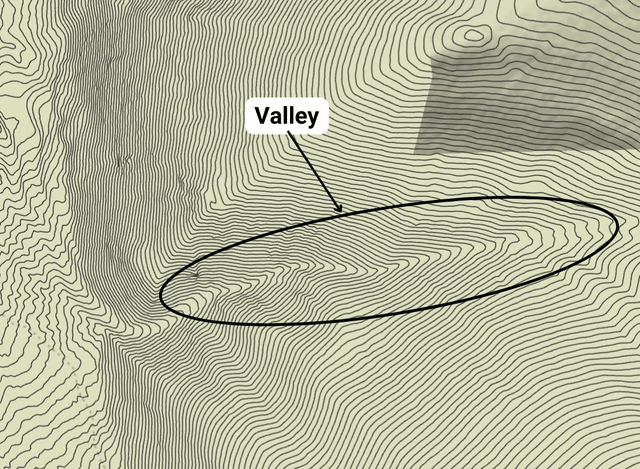Valley On Contour Map

In the realm of topography, contour maps serve as indispensable tools for visualizing the three-dimensional features of the Earth’s surface on a two-dimensional plane. Among the various elements that can be identified on these maps, valleys stand out as significant landforms that play crucial roles in shaping landscapes, influencing ecosystems, and impacting human activities. This article delves into the intricacies of identifying and understanding valleys on contour maps, blending technical precision with practical insights.
Understanding Contour Maps
Before exploring valleys, it’s essential to grasp the basics of contour maps. These maps use contour lines—curves that connect points of equal elevation—to represent the shape and elevation of the terrain. Key principles include:
- Contour Interval: The consistent vertical distance between contour lines, which determines the map’s detail level.
- Index Contours: Bold or labeled lines that indicate specific elevations at regular intervals.
- Depression Contours: Dashed lines within closed contours, representing areas below the surrounding terrain, such as sinkholes or small depressions.
Identifying Valleys on Contour Maps
Valleys are characterized by their elongated, low-lying areas flanked by higher ground. On contour maps, they manifest through distinct patterns:
V-Shaped Contour Lines:
In narrow valleys, contour lines form a V-shape, with the apex pointing upstream. This indicates a steep gradient and is typical of youthful or mountainous terrains.U-Shaped Contour Lines:
Wider valleys exhibit U-shaped contours, reflecting a gentler slope. This pattern often results from glacial erosion or mature river systems.Closely Spaced Contours:
Near the valley walls, contour lines are tightly packed, signifying a steep slope. As you move toward the valley floor, the spacing increases, indicating a flatter gradient.Convergence of Contours:
At the valley’s head, contours converge, often forming a distinct point or arc, depending on the valley’s origin (e.g., glacial cirque or fluvial erosion).
Expert Insight: The shape and spacing of contour lines not only reveal the valley's morphology but also hint at the geological processes that shaped it. For instance, U-shaped valleys often suggest glacial activity, while V-shaped valleys are typically associated with river erosion.
Types of Valleys and Their Contour Signatures
Valleys vary widely in their formation and characteristics, each leaving a unique imprint on contour maps:
River Valleys:
- Fluvial Erosion: Contours show a clear downstream direction, with V- or U-shaped patterns depending on the river’s maturity.
- Meanders: Oxbow lakes or abandoned channels appear as elongated, curved depressions with closely spaced contours.
- Fluvial Erosion: Contours show a clear downstream direction, with V- or U-shaped patterns depending on the river’s maturity.
Glacial Valleys:
- U-Shaped Profiles: Steep sides and a flat bottom, often with cirques (amphitheater-shaped contours) at the valley head.
- Hanging Valleys: Tributary valleys appear as contours elevated above the main valley floor, indicating differential erosion.
- U-Shaped Profiles: Steep sides and a flat bottom, often with cirques (amphitheater-shaped contours) at the valley head.
Structural Valleys:
- Fault or Rift Valleys: Straight, linear contours with abrupt changes in elevation, reflecting tectonic activity.
- Fold Valleys: Symmetrical contours on either side of a central ridge, formed by the folding of rock layers.
- Fault or Rift Valleys: Straight, linear contours with abrupt changes in elevation, reflecting tectonic activity.
Key Takeaway: The contour patterns of valleys are diagnostic tools for geologists and geographers, providing insights into the Earth's history and processes.
Practical Applications of Valley Identification
Understanding valleys on contour maps has far-reaching applications:
- Land Use Planning: Identifying valleys helps in determining suitable areas for agriculture, urban development, or conservation.
- Hydrology: Valleys are critical for water flow and drainage systems, influencing flood risk assessments and watershed management.
- Recreation and Tourism: Valleys often offer scenic landscapes and recreational opportunities, such as hiking or skiing.
- Environmental Studies: Valleys act as biodiversity hotspots, supporting unique ecosystems that require protection.
Challenges in Interpreting Valley Contours
While contour maps are powerful tools, their interpretation is not without challenges:
- Scale Limitations: Small-scale maps may oversimplify valley features, while large-scale maps can overwhelm with detail.
- Human-Made Alterations: Dams, quarries, or urban sprawl can distort natural valley contours.
- Map Projections: Distortions in map projections can affect the accuracy of contour representations.
Advantages of Contour Maps
- Provide detailed elevation data
- Allow visualization of terrain in 2D
- Support various scientific and practical applications
Limitations of Contour Maps
- Require training to interpret accurately
- Can be affected by map projection issues
- May not reflect real-time changes in terrain
Future Trends in Valley Mapping
Advancements in technology are revolutionizing how we map and analyze valleys:
- LiDAR and Drone Surveys: High-resolution elevation data provide unprecedented detail, capturing subtle valley features.
- GIS Integration: Geographic Information Systems allow for dynamic analysis of valley systems, incorporating multiple data layers.
- Machine Learning: Algorithms can automate the identification of valley patterns, reducing human error and increasing efficiency.
FAQ Section
How can I distinguish between a valley and a ridge on a contour map?
+Valleys are identified by contours forming V or U shapes with the open side facing downstream, while ridges show contours forming convex shapes uphill.
What do closely spaced contours in a valley indicate?
+Closely spaced contours signify a steep slope, typically found along the valley walls.
Can valleys be formed by processes other than water or ice?
+Yes, valleys can also result from tectonic activity (fault valleys) or volcanic eruptions (collapse valleys).
How do contour maps help in flood risk assessment?
+By identifying valley floors and floodplains, contour maps help predict areas prone to flooding during heavy rainfall or river overflow.
What is the role of contour intervals in valley interpretation?
+Contour intervals determine the level of detail in valley representation. Smaller intervals provide more precise elevation data, crucial for accurate analysis.
Conclusion
Valleys, as depicted on contour maps, are more than just low-lying areas—they are windows into the Earth’s geological history and dynamic processes. By mastering the art of interpreting contour lines, we unlock the ability to analyze landscapes, plan land use, and mitigate environmental risks. As technology continues to evolve, our understanding of valleys will deepen, ensuring their sustainable management for future generations.
Final Thought: Contour maps are not merely static representations but dynamic tools that bridge the gap between the Earth’s past and its future, with valleys serving as key narrative elements in this topographic story.
